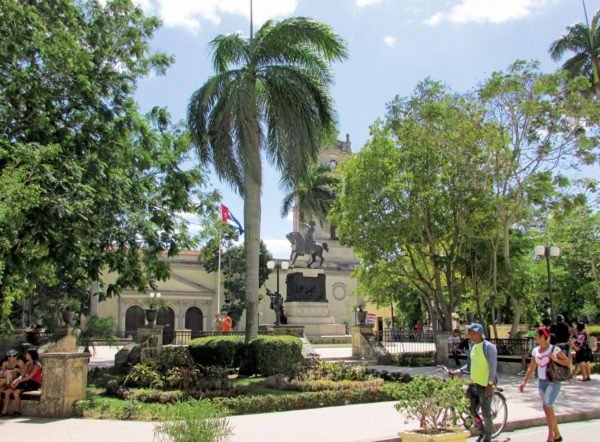For over 60 years Cuba has been off most cruisers’ itineraries. So, when the U.S. government loosened restrictions for American citizens, we decided to visit Cuba. And making the trip even more appealing was the fact that Cuba was just 75 miles from the Bahamas Ragged Islands, where we typically spend our winters. Once we received official permission from the U.S. government for myself, my wife Katie and our daughter Hoku to visit Cuba, aboard out catamaran Makana, off we sailed.
It took most of the day to sail from the Bahamas to Cuba arriving just before sunset at Puerto de Vita. Prior to entering the river leading to the marina we were instructed, in Spanish over the VHF radio, by the Cuban authorities to anchor off the marina and wait until morning for the doctor to board. With the yellow flag raised and the mystery of Cuba awaiting we settled in for our first Cuban sunset.

The next morning the doctor arrived, examined us and gave us the all clear to head into the marina. After being assisted with the Med-mooring tie up it took the better part of the morning to complete the check-in process. Fortunately, Katie’s knowledge of Spanish not only expedited the check-in process but would ultimately come in useful everywhere we went in Cuba. One of the few locals who did speak English was Janni the marina manager. In addition to her friendly demeanor she was very helpful. She assisted us in locating a rental car or a taxi and eager to help plan our visit.
Once we were cleared in and given permission to go ashore, our first order of business was to exchange money. I set off on my bicycle to the closest exchange, which was at the government-run resort six miles to the east. Riding through the small village of Puerto de Vita proper, I felt as if I had entered a time warp. The semi-paved road thru the village was lined with small single story homes bustling with activity. There was a social club where cold beer, rum and cigars were offered along with a bakery selling freshly baked Cuban bread. Horse drawn two wheeled buggies and four wheeled carriages and 1950s era American cars were the main modes of transport. The Russian Ladas were the minority along with older converted trucks serving as buses.

At the resort my U.S. dollars were exchanged for Cuban Unified Currency (CUC is pronounced “kook’s”). American credit cards or currency are presently not accepted as payment in Cuba. Next, I picked up the rental car Janni had reserved for us. While most of the vehicles we encountered on the roads were older, the rental was a surprising late model Fiat sedan. A few CUCs later, with my bike stowed in the trunk, I drove back to the marina, once again soaking up my new surroundings.
Cuban Cities
Puerto de Vita is located on the north coast 350 miles east of Havana, with Holguin, the closest major city, an hour’s drive to the west. For our two weeks’ stay we decided to tour the eastern third of the island. The cities of Holguin, Bayamo, Santiago de Cuba, Guantanamo, Baracoa and Camaguey sat at the top of the itinerary along with several historic sites and national parks. While each city was unique in its own way most of them had a Plaza de la Revolucion. While the cities and sights were impressive what surprised us and perhaps impacted us even stronger was the hospitality and happiness of the Cuban people.

The locals were always eager to engage in conversation. Although Katie did fine, my familiarity with the Spanish language was extremely limited. Most of my conversations were a mixture of Spanish, English and hand gestures resulting in what I called ‘kinetic Spanglish’. Nevertheless, once Katie initiated a conversation, we ran with it. And thanks to the patience of the locals, learn we did!
Accommodations
Our travels away from the marina found us spending each evening at a casa particular (private house). These typically have a room or two for rent to tourists at a set rate of 25 CUCs per night. And, for an additional charge, would include breakfast and/or dinner. These well-appointed accommodations often included amenities, such as air-conditioning, refrigerators, hot showers and rooftop sitting areas, typically not seen in most Cuban homes.
Life in Cuba
In Cuba we discovered a culture that has adapted well to limited resources. They use what is available in creative and ingenious ways. Trash alongside the road was practically non-existent as was graffiti or junk in yards or commercial areas. The locals demonstrated a great appreciation for refrigeration, electricity and toilet tissue with publicly supplied potable water seeming to be available most everywhere. The exception of availability was your typical grocery store. They were practically nonexistent! Those we encountered in the cities would be considered well stocked if your shopping list consisted of mayonnaise, tomato sauce, rice, beer and rum.

Outside of the cities the locals appeared to be self-sufficient, growing and raising their own food. Rice and vegetables were the main food source with pork, chicken and fish being luxuries. Rarely during our travels did we see cattle, beef was not offered in the stores and rarely seen on menus.
The People
The Cuban people were more than generous with what they had. They were always willing to offer advice, share a story, or lend a hand. In what felt like a blink of an eye our two weeks’ exploring came to an end and we departed. Sailing northward we reflected back on our experiences. We vowed to return someday as this enchanting island influenced us in a way we never imagined.

With Cuba reaching out to the world, don’t wait too long to experience for yourself the people and culture of this magical place.





